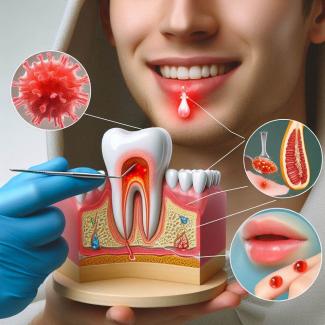
A granuloma is a small, localized nodular inflammation found in tissues due to a chronic inflammatory response. It is a distinct histopathological entity characterized by a collection of immune cells, primarily macrophages, which transform into a special type of cell known as epithelioid cells. These immune cells aggregate to form a granuloma as a defensive mechanism to wall off substances that the body perceives as foreign but is unable to eliminate.
Formation of a Granuloma
The formation of a granuloma is a complex process that involves the interaction of various cells and molecular signals. Here is a detailed explanation of how granulomas form:
- Initial Immune Response:
- When the body encounters a persistent pathogen, foreign material, or an irritant that it cannot easily remove, the immune system is activated. This could be due to infectious agents like bacteria, fungi, or parasites, or non-infectious agents like foreign bodies or certain autoimmune conditions.
- The innate immune system is the first line of defense, with macrophages and dendritic cells recognizing the invader through pattern recognition receptors (PRRs).
- Macrophage Activation:
- Macrophages, which are the primary cells involved in granuloma formation, engulf the foreign material through phagocytosis. However, if the material is resistant to degradation, such as the mycobacteria causing tuberculosis, the macrophages are unable to destroy it.
- In response, these macrophages become activated and transform into epithelioid cells, which are characterized by an elongated shape and an increased cytoplasmic volume.
- Cell Aggregation:
- Epithelioid cells begin to cluster together, forming the core of the granuloma. These cells often fuse to form multinucleated giant cells, such as Langhans giant cells, which are another hallmark of granulomas.
- The aggregation of these cells is facilitated by various cytokines and chemokines, including interferon-gamma (IFN-γ), tumor necrosis factor-alpha (TNF-α), and interleukin-12 (IL-12), which are secreted by T-helper cells (especially Th1 cells).
- Recruitment of Additional Immune Cells:
- Lymphocytes, particularly T-cells, are recruited to the site and form a surrounding layer around the macrophage core. This lymphocytic ring further strengthens the granuloma structure and enhances the immune response.
- Fibroblasts may also be recruited and can deposit collagen, leading to fibrosis and a more defined granulomatous structure.
- Sequestration and Containment:
- The primary function of a granuloma is to contain and isolate the offending agent, preventing its spread to other parts of the body. This containment can sometimes lead to the formation of a necrotic center, particularly in cases of infectious granulomas like those caused by tuberculosis, where the center may undergo caseous necrosis (a cheese-like tissue death).
Types of Granulomas
Granulomas can be classified based on their etiology into several types:
- Infectious Granulomas:
- Caused by persistent infectious agents such as Mycobacterium tuberculosis (tuberculosis), fungi (histoplasmosis, coccidioidomycosis), or parasites (schistosomiasis).
- Foreign Body Granulomas:
- Formed in response to foreign materials such as sutures, splinters, or certain inhaled substances like silica or asbestos.
- Immune Granulomas:
- Result from chronic inflammatory diseases and autoimmune conditions, such as sarcoidosis, Crohn’s disease, and rheumatoid arthritis.
- Granulomatous Diseases of Unknown Etiology:
- Some conditions, like sarcoidosis, have granulomas without a clearly defined cause.
Clinical Significance
Granulomas are clinically significant as they indicate a chronic inflammatory response and can affect the function of the tissues where they form. Depending on their location and cause, granulomas can lead to various symptoms and complications. For instance:
- Pulmonary Granulomas: Commonly seen in tuberculosis and sarcoidosis, these can cause respiratory symptoms like cough, shortness of breath, and chest pain.
- Hepatic Granulomas: These may result from infections, drug reactions, or systemic diseases and can affect liver function.
- Oral Granulomas: Often related to dental infections or foreign bodies, these can cause pain, swelling, and discomfort in the oral cavity.
Diagnosis and Treatment
Diagnosing granulomas typically involves imaging studies like X-rays, CT scans, or MRIs, along with histopathological examination of biopsy samples. Identifying the underlying cause is crucial for effective treatment, which may include:
- Antibiotics or Antifungals: For infectious granulomas.
- Immunosuppressive Therapy: For autoimmune or inflammatory causes.
- Surgical Removal: For foreign body granulomas or if the granuloma causes significant obstruction or dysfunction.
Granulomas are indicative of the body's effort to contain a challenging threat, highlighting the dynamic interplay of immune cells in maintaining homeostasis and defending against persistent insults.
How to Cushion a Granuloma
Cushioning a granuloma involves several strategies aimed at alleviating symptoms, reducing inflammation, and promoting healing. A granuloma, being a localized nodular inflammation, can cause discomfort, pain, and functional impairment depending on its location. Here’s a comprehensive guide on how to cushion and manage a granuloma:
Understanding Granuloma Cushioning
Cushioning a granuloma refers to the measures taken to provide symptomatic relief and minimize irritation. These measures do not replace professional medical treatment but can complement it, especially in managing pain and discomfort while awaiting definitive care.
Steps to Cushion a Granuloma
1. Local Anesthetic Applications
Using topical anesthetics can provide temporary pain relief:
- Lidocaine Gel or Ointment: Applying lidocaine or similar local anesthetics directly on the granuloma can numb the area and reduce pain.
- Benzocaine Products: Over-the-counter benzocaine gels can also be used for temporary relief.
2. Anti-inflammatory Medications
Reducing inflammation is crucial for cushioning a granuloma:
- Nonsteroidal Anti-inflammatory Drugs (NSAIDs): Medications like ibuprofen or naproxen can reduce pain and inflammation. These should be taken according to the recommended dosage and under medical advice.
- Corticosteroid Creams or Injections: For granulomas on the skin or in accessible areas, corticosteroid creams can reduce inflammation. In some cases, a healthcare provider might administer corticosteroid injections directly into the granuloma to decrease inflammation and size.
3. Warm Compresses
Applying warm compresses can soothe the affected area:
- Warm, Moist Cloth: Applying a warm, moist cloth to the area for 15-20 minutes several times a day can improve blood flow and reduce discomfort.
- Epsom Salt Soaks: If the granuloma is in an accessible area, soaking in warm water with Epsom salts can provide relief.
4. Good Oral Hygiene Practices
For granulomas in the oral cavity, maintaining proper oral hygiene is essential:
- Regular Brushing and Flossing: Use a soft-bristled toothbrush to avoid further irritation.
- Antiseptic Mouthwash: Rinsing with an antiseptic mouthwash can help reduce bacterial load and prevent secondary infections.
5. Protective Dressings
Covering the granuloma can prevent further irritation:
- Sterile Gauze: For skin granulomas, applying a sterile gauze pad can protect the area from friction and contamination.
- Dental Wax: In the case of oral granulomas, dental wax can be applied over sharp dental appliances or braces that might be causing irritation.
6. Soft Diet
Adopting a soft diet can minimize mechanical irritation of oral granulomas:
- Soft Foods: Consuming foods like yogurt, mashed potatoes, and smoothies can help avoid aggravating the granuloma.
- Avoiding Irritants: Spicy, acidic, or hard foods should be avoided as they can worsen the inflammation and pain.
Professional Medical Interventions
While the above methods can provide symptomatic relief, addressing the underlying cause of the granuloma is essential for long-term management:
1. Antibiotic or Antifungal Therapy
For infectious granulomas, appropriate antimicrobial treatment is necessary:
- Bacterial Infections: Antibiotics may be prescribed based on the type of bacteria involved.
- Fungal Infections: Antifungal medications are used to treat granulomas caused by fungal pathogens.
2. Surgical Intervention
In some cases, surgical removal of the granuloma may be required:
- Excision: Surgical excision can be performed to remove the granuloma entirely, especially if it is causing significant discomfort or is not responding to other treatments.
- Drainage: If the granuloma is associated with an abscess, drainage might be necessary.
3. Endodontic Treatment
For dental granulomas, root canal therapy can be performed to treat the infected tooth and prevent further irritation:
- Root Canal Therapy: This involves cleaning and sealing the root canals of the affected tooth to eliminate infection and promote healing.
Monitoring and Follow-Up
Regular monitoring and follow-up with a healthcare provider are crucial:
- Regular Check-ups: Regular dental or medical check-ups can ensure that the granuloma is healing properly and that no complications arise.
- Biopsy: In some cases, a biopsy may be performed to rule out malignancy or other serious conditions.
Management of Granuloma-Related Gum Pain
Granulomas on the gums can cause significant discomfort and pain due to their inflammatory nature. While addressing the underlying cause of the granuloma through professional dental care is essential, there are several measures that can be taken to alleviate gum pain associated with a granuloma. Here's a comprehensive guide on managing gum pain from a granuloma:
Understanding Gum Pain from Granuloma
Granulomas on the gums typically arise from chronic inflammation in response to dental infections, trauma, or irritation from foreign bodies. The pain can vary from mild discomfort to sharp, throbbing pain depending on the size and location of the granuloma. Effective pain management aims to reduce inflammation, alleviate discomfort, and promote healing of the affected gum tissue.
Strategies to Reduce Gum Pain
1. Topical Anesthetics
Applying topical anesthetics directly to the affected area can provide immediate relief by numbing the gum tissue:
- Benzocaine Gel: Over-the-counter benzocaine gels are commonly used to numb the gums and reduce pain. These gels should be applied sparingly and according to the product instructions to avoid potential side effects.
- Lidocaine Ointment: Prescription-strength lidocaine ointments can also be used under the guidance of a healthcare provider to manage severe gum pain.
2. Anti-inflammatory Medications
Reducing inflammation can help alleviate pain and discomfort associated with a granuloma:
- Nonsteroidal Anti-inflammatory Drugs (NSAIDs): Medications such as ibuprofen (Advil, Motrin) or naproxen (Aleve) can be taken orally to reduce inflammation and relieve gum pain. These medications should be used according to the recommended dosage and duration to minimize side effects.
- Corticosteroid Gels: Prescription-strength corticosteroid gels or creams may be recommended by a dentist to reduce inflammation locally on the gums.
3. Warm Salt Water Rinses
Rinsing the mouth with warm salt water can help soothe inflamed gums and reduce pain:
- Salt Water Solution: Mix half a teaspoon of salt in a cup of warm water. Use this solution to rinse your mouth gently several times a day, especially after meals. Salt water helps reduce swelling and promotes healing of the gum tissue around the granuloma.
4. Cool Compresses
Applying a cool compress externally can provide temporary relief from gum pain:
- Cold Pack: Wrap a few ice cubes in a thin cloth or use a cold pack and apply it to the outside of the cheek near the affected area for 10-15 minutes. This can help numb the area and reduce swelling.
5. Soft Diet and Avoidance of Irritants
Adopting a soft diet and avoiding foods that can irritate the gums can minimize discomfort:
- Soft Foods: Stick to soft, easy-to-chew foods such as soups, yogurt, mashed potatoes, and smoothies until the gum pain subsides.
- Avoid Irritants: Steer clear of spicy, acidic, or crunchy foods that can aggravate the granuloma and cause further pain.
6. Good Oral Hygiene Practices
Maintaining proper oral hygiene is crucial to prevent worsening of the granuloma and associated gum pain:
- Gentle Brushing and Flossing: Use a soft-bristled toothbrush to gently clean your teeth and gums twice a day. Pay extra attention to the area around the granuloma, but avoid aggressive brushing that can irritate the gums.
- Antiseptic Mouthwash: Rinse with an antiseptic mouthwash to help reduce bacterial load and prevent secondary infections that can exacerbate gum pain.
Professional Dental Treatment
While these measures can provide temporary relief, seeking professional dental care is essential for effective management of gum pain from a granuloma:
- Dental Examination: A dentist will assess the granuloma and its underlying cause, which may require X-rays or other diagnostic tests.
- Treatment Plan: Depending on the diagnosis, treatment options may include root canal therapy, antibiotics, surgical excision of the granuloma, or other interventions tailored to address the specific cause of the gum pain.
- Follow-Up Care: Regular follow-up appointments with the dentist ensure that the granuloma is properly managed and any necessary adjustments to the treatment plan are made.
Sage and its Potential Role in Managing Granuloma Pain
Sage (Salvia officinalis) is a medicinal herb known for its anti-inflammatory, antimicrobial, and antioxidant properties. While sage has been traditionally used for various health purposes, including oral health, its specific role in managing granuloma pain has limited scientific evidence. Here's an exploration of sage's properties and its potential impact on granuloma-related pain:
Understanding Granuloma Pain
Granulomas, which are localized inflammatory nodules, can cause pain and discomfort depending on their location and underlying cause. In the oral cavity, granulomas on the gums or around teeth can lead to sensitivity, swelling, and throbbing pain due to the inflammatory response and potential infection.
Sage's Anti-inflammatory Properties
Sage contains several bioactive compounds, including flavonoids, phenolic acids, and volatile oils, which contribute to its medicinal properties:
- Anti-inflammatory Effects: Sage has been studied for its ability to inhibit inflammatory pathways. Compounds like rosmarinic acid and luteolin found in sage have demonstrated anti-inflammatory effects by reducing the production of pro-inflammatory cytokines and enzymes that contribute to tissue inflammation.
- Antioxidant Activity: Sage is rich in antioxidants that can neutralize free radicals and reduce oxidative stress, which is implicated in chronic inflammatory conditions.
Potential Mechanisms of Action for Pain Relief
While scientific studies specifically evaluating sage for granuloma pain are limited, its anti-inflammatory and antioxidant properties suggest several potential mechanisms through which it could alleviate pain associated with granulomas:
- Reduction of Inflammation: Sage may help modulate the inflammatory response that contributes to granuloma formation and pain. By inhibiting inflammatory mediators, sage could potentially reduce swelling and discomfort around the granuloma site.
- Antimicrobial Effects: Some granulomas are associated with infections, especially in dental granulomas caused by bacterial infiltration. Sage's antimicrobial properties could help combat these pathogens, potentially reducing pain associated with infection.
- Antioxidant Protection: Oxidative stress can exacerbate inflammation and contribute to tissue damage. Sage's antioxidants may help protect against oxidative damage and support tissue healing around the granuloma.
Practical Application of Sage for Granuloma Pain
If considering sage for managing granuloma pain, it's important to approach it cautiously and in conjunction with professional medical advice:
- Topical Application: Sage essential oil or diluted sage extract could be applied topically to the affected gum area. This might help reduce inflammation and provide local pain relief. However, care should be taken to ensure proper dilution and to avoid direct application to open wounds or mucous membranes without guidance from a healthcare provider.
- Oral Consumption: Drinking sage tea or using sage as a culinary herb may provide systemic anti-inflammatory benefits. However, the concentration of active compounds in culinary preparations may be lower compared to concentrated extracts or supplements.
Considerations and Precautions
- Consultation with a Healthcare Provider: Before using sage or any herbal remedy for granuloma pain, it's crucial to consult with a dentist or healthcare provider. They can provide guidance based on the specific nature of the granuloma, underlying conditions, and overall health status.
- Potential Interactions: Sage supplements or extracts may interact with medications or exacerbate certain health conditions. Individuals with allergies to other members of the Lamiaceae family (such as mint or oregano) should exercise caution.
Natural Plants for Relieving Pain in Diseased Tooth and Gum
When dealing with pain in a diseased tooth and gum, natural plants can offer soothing relief while potentially aiding in reducing inflammation and promoting healing. It's essential to understand the context of granulomatous conditions affecting the oral cavity, as these can cause significant discomfort due to inflammation and possible infection. Here’s a comprehensive exploration of natural plants that may be beneficial for alleviating pain associated with granulomas on teeth and gums:
Understanding Granuloma-Related Pain
Granulomas in the oral cavity, such as those on the gums or around teeth, often result from chronic inflammation in response to infection, trauma, or irritants. The pain can range from mild to severe, affecting daily activities such as eating and oral hygiene practices.
Natural Plants with Pain-Relieving Properties
Several natural plants have been traditionally used for their analgesic, anti-inflammatory, and antimicrobial properties, making them potential candidates for alleviating pain in diseased teeth and gums:
1. Cloves (Syzygium aromaticum)
- Active Compound: Eugenol is the primary active component in cloves, known for its analgesic and antibacterial properties.
- Application: Clove oil or crushed cloves can be applied topically to the affected tooth and gum area. Eugenol acts as a local anesthetic and provides temporary pain relief.
- Caution: Direct application of undiluted clove oil can cause irritation, so it should be diluted before use. Individuals with bleeding disorders or allergies to cloves should avoid its use.
2. Tea Tree Oil (Melaleuca alternifolia)
- Active Compound: Terpinen-4-ol in tea tree oil exhibits antimicrobial and anti-inflammatory effects.
- Application: Diluted tea tree oil can be applied topically to the affected area using a cotton swab. It helps reduce inflammation and fight oral infections associated with granulomas.
- Caution: Tea tree oil should be used cautiously and diluted properly to avoid irritation. It should not be swallowed as it can be toxic if ingested in large amounts.
3. Aloe Vera (Aloe barbadensis)
- Active Compounds: Polysaccharides and glycoproteins in aloe vera have anti-inflammatory and wound-healing properties.
- Application: Fresh aloe vera gel can be applied directly to the affected gum area to soothe inflammation and promote healing. It also provides a cooling effect that helps relieve pain.
- Caution: Use pure aloe vera gel from the inner leaf. Some commercial products may contain additives that can cause irritation.
4. Chamomile (Matricaria chamomilla)
- Active Compounds: Chamazulene and bisabolol in chamomile have anti-inflammatory and soothing effects.
- Application: Chamomile tea can be brewed and used as a mouthwash or compress to reduce inflammation and relieve pain in the gums. It is gentle and suitable for sensitive oral tissues.
- Caution: People allergic to ragweed or other plants in the Asteraceae family may also be allergic to chamomile.
5. Turmeric (Curcuma longa)
- Active Compound: Curcumin is the main bioactive component in turmeric, known for its anti-inflammatory and antioxidant properties.
- Application: A paste made from turmeric powder and water can be applied topically to the gums to reduce inflammation and pain. It can also be added to warm water for oral rinsing.
- Caution: Turmeric can stain clothing and surfaces, and excessive use may cause oral mucosa irritation in some individuals.
Considerations for Use
When using natural plants for pain relief in granuloma-affected teeth and gums, consider the following:
- Consultation: Always consult with a dentist or healthcare provider before using natural remedies, especially if the granuloma is due to a dental infection.
- Allergies and Sensitivities: Be aware of potential allergies or sensitivities to specific plants. Perform a patch test before applying any plant-based remedy to ensure no adverse reactions occur.
- Supervision: Follow recommended dosages and application methods to avoid unintended side effects or complications.
Natural plants offer a holistic approach to managing pain and inflammation associated with granulomas on teeth and gums. Their analgesic, anti-inflammatory, and antimicrobial properties can provide relief while supporting the body’s healing process. Integrating these natural remedies with professional dental care ensures comprehensive management of granulomatous conditions, promoting oral health and overall well-being.






